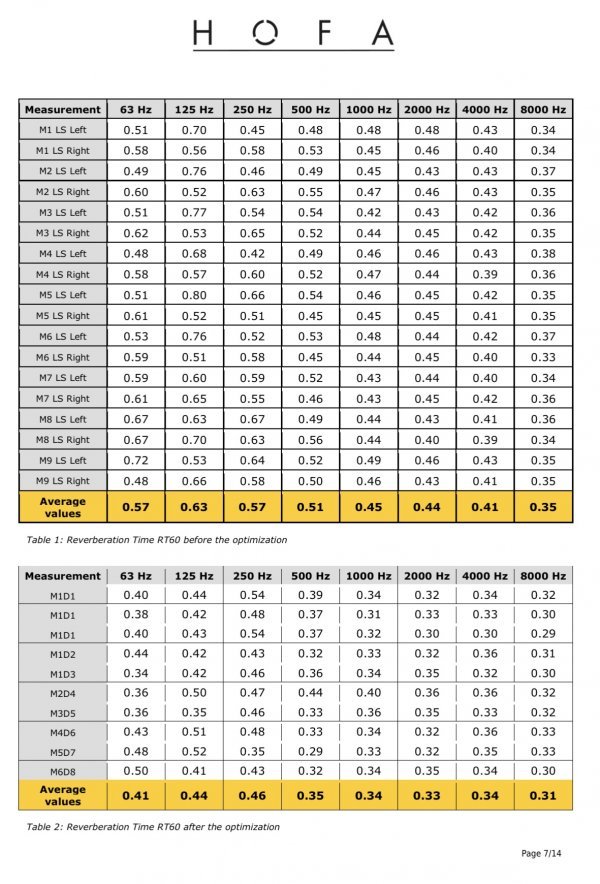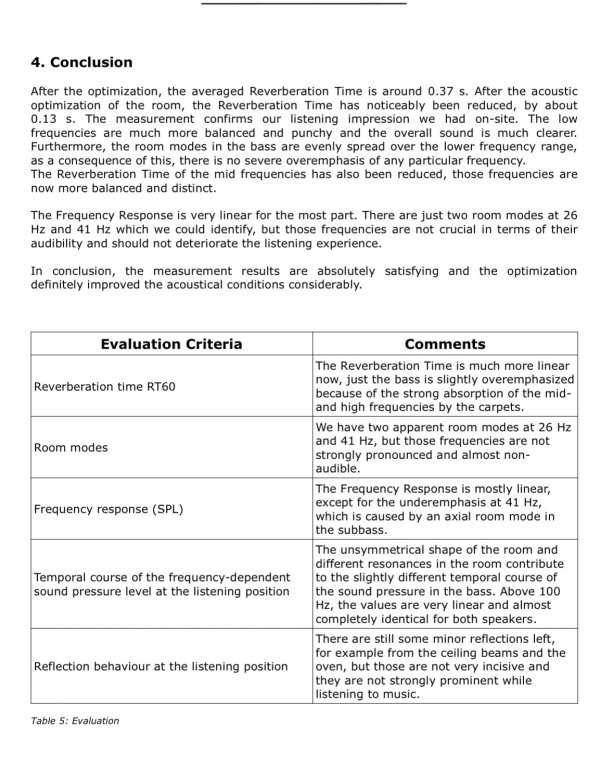Hi,
I've researched different companies from Acoustic Fields (Dennis Foley) to Verbox, Sonitus and Artnovian.
The spectrum represents the balance between practicality, cost effectiveness, looks and effectiveness of the products.
Acoustic Fields sells bulky and expensive furniture going to very low frequencies. Not very transparent in communication and looks not very cost effective to me. Based on the number of those bulky boxes I would need, I would be better off getting 4 subs and placing them around the room: both cheaper and takes less space and has better looks.
The other end of the spectrum is Artnovian. Their 60mm thick panels look good, but don't absorb well below 300Hz:
 www.artnovion.com
www.artnovion.com
I went to a demo room with $180,000 worth of equipment and $6,000 worth of room treatment and the sound was not good even for my unsophisticated ears. They guy also mentioned spending $3000 on the carpet as part of the room treatment, which shows their level of knowledge in the area.
They would not let me measure the room response using REW. It appears they are focused on selling expensive hardware and when I spoke to them about room treatment they kept moving towards expensive processors and the like.
In the middle range is Verbox and Sonitus. The first one only sells absorbers, their ultra option claims to go to 100Hz:

 verbox.com.au
Which is good enough to sort out the rest with subwoofers. The problem is, they don't have any independent tests and can't provide the entire solution. So far the sweet spot to me is Sonitus. On their US website you can select a pre-built setup for a certain room size and level of sound quality you want. I've attached the setup screenshot, as the link would not work. There is a problem though. Their most powerful absorber (Legato 12) only goes to 200Hz at .8 absorption coefficient, leaving a gap between 100Hz and 200Hz. Also, I am not convinced that the bass traps in the two front corners would be enough, given the small area they cover. I could not find a single demo room in Sydney which was properly treated and in which I could measure the room response or the shop would have such measurement.
verbox.com.au
Which is good enough to sort out the rest with subwoofers. The problem is, they don't have any independent tests and can't provide the entire solution. So far the sweet spot to me is Sonitus. On their US website you can select a pre-built setup for a certain room size and level of sound quality you want. I've attached the setup screenshot, as the link would not work. There is a problem though. Their most powerful absorber (Legato 12) only goes to 200Hz at .8 absorption coefficient, leaving a gap between 100Hz and 200Hz. Also, I am not convinced that the bass traps in the two front corners would be enough, given the small area they cover. I could not find a single demo room in Sydney which was properly treated and in which I could measure the room response or the shop would have such measurement.
So far I am considering combining Sonitus set with some Ultra panels from Verbox to fix the gap. I am also considering addressing below 100Hz range with additional subs and building a bass traps in my riser which is 305mm thick. The problem with the last option is that I could not find an expert for designing the bass trap in the riser. All I know is you need to fill it with insulation and make ventilation holes to allow the sound in. I have not idea on where to put those holes, how big and how many.
Any ideas? What was your room treatment journey?
Thanks.
I've researched different companies from Acoustic Fields (Dennis Foley) to Verbox, Sonitus and Artnovian.
The spectrum represents the balance between practicality, cost effectiveness, looks and effectiveness of the products.
Acoustic Fields sells bulky and expensive furniture going to very low frequencies. Not very transparent in communication and looks not very cost effective to me. Based on the number of those bulky boxes I would need, I would be better off getting 4 subs and placing them around the room: both cheaper and takes less space and has better looks.
The other end of the spectrum is Artnovian. Their 60mm thick panels look good, but don't absorb well below 300Hz:
Artnovion Acoustics - Hi-Fi & Living Room
Design your ultimate Home Cinema, Hifi room or Media room, with our collection of acoustic treatment solutions.
I went to a demo room with $180,000 worth of equipment and $6,000 worth of room treatment and the sound was not good even for my unsophisticated ears. They guy also mentioned spending $3000 on the carpet as part of the room treatment, which shows their level of knowledge in the area.
They would not let me measure the room response using REW. It appears they are focused on selling expensive hardware and when I spoke to them about room treatment they kept moving towards expensive processors and the like.
In the middle range is Verbox and Sonitus. The first one only sells absorbers, their ultra option claims to go to 100Hz:

V Panel – Verbox
The V Panel is a high quality, broadband frequency absorber made from high density, 100% allergy and irritant free polyester insulation covered with a durable and breathable polyester acoustic specific fabric. They are designed to minimise room reflections and reverberation in a space to create...
So far I am considering combining Sonitus set with some Ultra panels from Verbox to fix the gap. I am also considering addressing below 100Hz range with additional subs and building a bass traps in my riser which is 305mm thick. The problem with the last option is that I could not find an expert for designing the bass trap in the riser. All I know is you need to fill it with insulation and make ventilation holes to allow the sound in. I have not idea on where to put those holes, how big and how many.
Any ideas? What was your room treatment journey?
Thanks.











